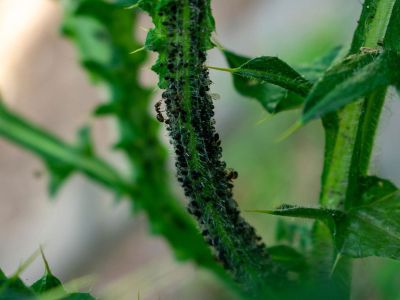Ants help us by eating fleas, caterpillars, termites, and dead remains of insects and animals. They eat the waxy material from peony buds, allowing them to fully bloom. With all these attributes, if you still want to know how to get rid of ants, or need help controlling multitudes of ants, read on.
Ants in the Garden
In your garden ants are primarily interested in insects that produce sticky “honeydew,” like aphids, whiteflies, scales, and mealybugs; all of which can do considerable damage to your plants. Ants have the job of protecting, cultivating, and consuming insects that are more destructive. Ants are socially divided into castes of workers, males, and queens. If you’re seeing a plethora of ants in your garden, it’s a good idea to try and track down the mound where the ants have formed and built their colony. While you’re at it, examine your plants to see if they have tinier, more destructive creatures that have drawn the ants. Your plants could probably use a few doses of neem oil.
How to Get Rid of Ants
There are more than 12,000 species of ants. They are fascinating creatures and, although they perform a lot of beneficial tasks, gardeners often find their presence a bit overwhelming. Large infestations may start migrating into your house in search of more food and you may become interested in getting rid of ants. There are many ant-killing pesticides on the market but controlling ants naturally in your garden may be a better idea. Especially if you’re growing edible plants, you don’t want to use pesticides that can contaminate your plants and groundwater. If it’s time to get rid of them, it’s helpful to begin by finding where ants live. Their nests are often found in mounds. If you can locate their trail and trace it to a mound, you will be able to eliminate most of them, since they will always try to return to their nest. One great solution is a sprinkling of diatomaceous earth over the ant mound. The sharp edges of the granules kill ants and other insects as they digest it. Diatomaceous earth comes from dead sea creatures called diatoms and can be found at almost any garden nursery. One drawback to this method is that it needs to stay dry to be effective, so it should be re-applied after rain or watering. Borax placed in bottles mixed with a dab of jelly will attract ants. Ants cannot digest the borax and will die, taking many of their nesting family members with them. Borax can be toxic to pets so use judiciously. A few handfuls of cornmeal or baby powder on ant mounds can prove effective in eradicating ants. Some experts also suggest using a tea made from pipe tobacco. Just soak the tobacco in water overnight and pour the liquid into the ant mounds, wearing gloves to protect your hands. For small numbers of ants, apply vinegar and water to the area. While we appreciate ants for their ability to warn us of other infestations and for the cleanup work they perform, they can certainly become a nuisance. If possible, try some of these safer methods before resorting to chemicals.
